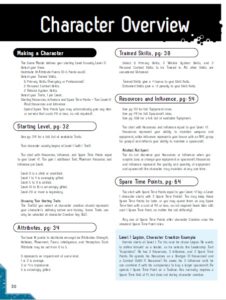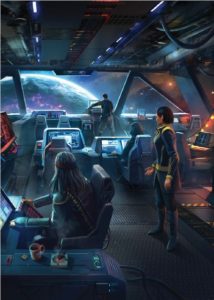Review: Fragged Empire
 A concession of middle age, but I’m finally starting to warm up to space opera or, science fantasy themed RPGs. I’m still yet to delve into the major IPs. I haven’t read any RPG version of Star Wars, nor did Star Trek ever make it to my table. I’ve played Traveller twice. Admittedly, it’s taken awhile. While the excitement about Paizo’s recent release of Starfinder is almost tangible… And on the cusp of Wade Dyer’s third successfully funded Kickstarter, now might be a good a time as any for closer look at Fragged Empire.
A concession of middle age, but I’m finally starting to warm up to space opera or, science fantasy themed RPGs. I’m still yet to delve into the major IPs. I haven’t read any RPG version of Star Wars, nor did Star Trek ever make it to my table. I’ve played Traveller twice. Admittedly, it’s taken awhile. While the excitement about Paizo’s recent release of Starfinder is almost tangible… And on the cusp of Wade Dyer’s third successfully funded Kickstarter, now might be a good a time as any for closer look at Fragged Empire.
Fragged Empire certainly offers a distinct and unique space fantasy setting. A post-post-apocalyptic universe; far removed from the extinction of the human race, and one hundred years from the extinction of humanities genetically engineered descendant, the Archons. Remember post, post. Four distinct races/cultures, each of which the players have the opportunity to make a characters, fight for survival in the cold, dark and war-torn galaxy of Haven.
The setting itself is well done, and presented in my favorite way: A respectable amount of detail and good amount left for the GM to fill in. Stellar maps outline the Haven system and the major locations receive plenty of text. The setting and tone is also presented through a series of short stories between sections. While I usually skip past these, the two I read weren’t awful. In your average RPG product, they usually are. Sorry, “average RPG product,” the truth hurts. The GM should find plenty of ideas for crafting adventures and the GM section has short treatment of adventure hooks just in case. The most expansive aspects of this setting describe the history, cultural differences, and tension between the four playable races.
 With character creation players have a choice of four races: the Corporation, Kaltorans, Legion, or Nephilim, to make a character. Fragged Empire is for the most part a classless system. However, each race is somewhat scoped (due to genetic engineering) into specific role(s), and the creation guidelines provide 3 or more character (suggestions) templates for each.
With character creation players have a choice of four races: the Corporation, Kaltorans, Legion, or Nephilim, to make a character. Fragged Empire is for the most part a classless system. However, each race is somewhat scoped (due to genetic engineering) into specific role(s), and the creation guidelines provide 3 or more character (suggestions) templates for each.
Corporation characters will be left to subterfuge; the most easily accessed strengths being negotiation and social connections (and, have vital importance with this RPGs sub-system). Kaltorans will likely fill the role of the party smuggler or thief, though this species has a good amount of general utility. Legion will likely fill the role of solider or mercenary. While Nephilim and their cultural drive for genetic perfection is probably the most flexible species of the four. Each race has a specific template of (+/-) modifiers towards attributes, skills and other abilities.
Character creation with Fragged Empire is involving, requiring more than a few flips back and forth due to the amount of detail. The layout doesn’t help this and it extends to gear and other aspects. Players who are familiar with crunchier systems will likely spend extra time making decisions because of the wealth of material. Due to the intricacy (and importance) of character creation, players creating characters in a bubble is not the best idea. Which, I’ll get to why in a moment. After the race is selected, players will distribute 18 points among 6 attributes, select 10 trained skills and select one Trait (special ability) from among one of the skills chosen.
Note: Fragged Empire doesn’t have a standard monetary system (Item A costs: credits/cash) instead, the game relies on an intricate series of system management tools, from everything to weapons, technological tools, to the capability of the starship the players will rely, to jaunt about the universe.
 Last in character creation is calculating each character’s starting Resources, Influence and Spare Time Points. Resources will directly tie into each characters gear, weapons and equipment etc., including the number of specific items the character can have in their possession, as well as the care or maintenance of these items. The equipment available depends on how many slots (resources) the character has.
Last in character creation is calculating each character’s starting Resources, Influence and Spare Time Points. Resources will directly tie into each characters gear, weapons and equipment etc., including the number of specific items the character can have in their possession, as well as the care or maintenance of these items. The equipment available depends on how many slots (resources) the character has.
The combined number of Influence points (each character receives 1 per level, but maybe further modified by race, Trait selection or game rewards) will determine the ability that the group can utilize their starship, and maintain its capability mechanically and financially: repairs, maintenance and seeking service at a space station etc. If they player group is low on Influence, this will directly affect the type of weapons systems their starship has, as well as their ability to use its standard systems. Spare Time Points are used as a method to acquire upgrades and new equipment.
Though I’m covering it only in brief, I’ve never been in favor of system management (a sort of min-game) within a RPG, due to the break of immersion. The important question: what is the purpose of such a system? For Fragged Empire the answer seems to consist of two parts: Pushing aside the mundane details for more “epic” level play and assisting the GM with managing the player group… But, there is a potential problem here, as player characters will likely manage themselves (or worse each other), in order to acquire the equipment they want and utilize a starship effectively, especially if the game goes longer than a few sessions.  What’s in place seems more of a distraction, especially considering the game itself is built on cultural tension and it will be unlikely that players will want to create characters of identical race. While it might be slightly more efficient than a standard monetary system (admittedly as clunky as those are), it also takes some of the choices away from the player characters, which might be a good reason to implement such a thing if you’re in favor (promise I won’t judge you) of these kinds of limits. I will say, what’s present in this material is detailed enough and with a little common sense, chucking out the system management aspects is certainly (and exactly what I would do) possible.
What’s in place seems more of a distraction, especially considering the game itself is built on cultural tension and it will be unlikely that players will want to create characters of identical race. While it might be slightly more efficient than a standard monetary system (admittedly as clunky as those are), it also takes some of the choices away from the player characters, which might be a good reason to implement such a thing if you’re in favor (promise I won’t judge you) of these kinds of limits. I will say, what’s present in this material is detailed enough and with a little common sense, chucking out the system management aspects is certainly (and exactly what I would do) possible.
The core mechanic of Fragged Empire primarily utilizes 3d6+ the skill rank against a target number set by the GM. For a specific task, players are encouraged to select a skill which they think fits the situation, narrate their characters actions and may receive additional points (if the GM likes the description) based on the narrative. Each skill is well outlined in its suggested use and rules beyond skill rolls are more than covered with this system.
The PDF digitizing before my screen is 385 pages cover to cover. The look of Fragged Empire is excellent, due in no small part to the quality and frequency of full color illustrations. As mentioned, I’m not a huge fan of the overall layout of the text, but the writing itself is certainly above par.
 Overall, Fragged Empire receives a mixed review and it seems at almost every turn of the page something I like is weighed down with something I didn’t care for. This is a top-notch product and on par with the big boys, but the layout and overall arrangement of the material suffers in organization. The detail of equipment, weapons, and guidelines for creating starships, is done well, but acquisition is ruled by a sub-system, which I’d have no use of. The writing is respectable, the setting and cultural history elements are far above the mark of most settings, but at 385 pages the game suffers some bloat (though this is also tied to organization). Characters are well-balanced (and not too unwieldy) and a campaign will likely be best served with a mix of each race, while at the same time cultural tension is a core theme throughout.
Overall, Fragged Empire receives a mixed review and it seems at almost every turn of the page something I like is weighed down with something I didn’t care for. This is a top-notch product and on par with the big boys, but the layout and overall arrangement of the material suffers in organization. The detail of equipment, weapons, and guidelines for creating starships, is done well, but acquisition is ruled by a sub-system, which I’d have no use of. The writing is respectable, the setting and cultural history elements are far above the mark of most settings, but at 385 pages the game suffers some bloat (though this is also tied to organization). Characters are well-balanced (and not too unwieldy) and a campaign will likely be best served with a mix of each race, while at the same time cultural tension is a core theme throughout.
As excellent as it looks, Fragged Empire just wasn’t my cup of coffee…
Available at DriveThruRPG, Amazon, and FraggedEmpire.com.
Special Thanks
Thanks to our Patreon backers for helping fund this article, including Sean Holland, Games Finder, Jared Sloan, Andy Venn, Kimberly Hankins, Lester Ward, and Matthew Yun. Also, thank you to our latest backer, Brian Liberge!
